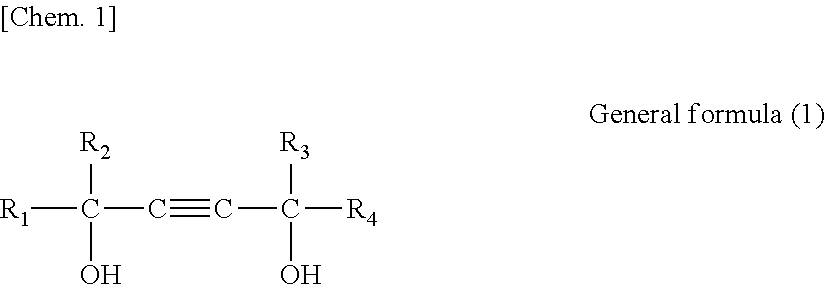Method for producing binder for inkjet printing ink, inkjet printing ink, and printed material
a technology of inkjet printing and binder, which is applied in the direction of instruments, optical elements, transportation and packaging, etc., can solve the problems of clogging of ink discharge nozzles and shortening the level of ink composition, and achieve good ink dischargeability, high quick-drying property, and blend stability
- Summary
- Abstract
- Description
- Claims
- Application Information
AI Technical Summary
Benefits of technology
Problems solved by technology
Method used
Image
Examples
example 1
[0133]Into a container equipped with a thermometer, a nitrogen gas inlet tube, and a stirrer and purged with nitrogen, 64.2 parts by mass of methyl ethyl ketone was added and 18.4 parts by mass of 2,2-dimethylol propionic acid and 33.9 parts by mass of isophorone diisocyanate were mixed in the methyl ethyl ketone. The reaction was conducted for 4 hours at 80° C. After 4 hours, 38.2 parts by mass of methyl ethyl ketone was further fed, the resulting mixture was cooled to 60° C. or less, and 140.1 parts by mass of polyether polyol (polytetramethylene glycol “PTMG 2000” produced by Mitsubishi Chemical Corporation, number-average molecular weight: 1000) and 0.01 parts by mass of dibutyl tin dilaurate (DBTDL hereinafter) were further added to the mixture. The reaction was continued at 80° C.
[0134]After confirming that the weight-average molecular weight of the reaction product had reached a range of 20000 to 50000, 1.3 parts by mass of methanol was added to terminate the reaction. Then 4...
example 2
[0139]Into a container equipped with a thermometer, a nitrogen gas inlet tube, and a stirrer and purged with nitrogen, 63.9 parts by mass of methyl ethyl ketone was added and 18.2 parts by mass of 2,2-dimethylol propionic acid and 52.3 parts by mass of isophorone diisocyanate were mixed in the methyl ethyl ketone. The reaction was conducted for 4 hours at 80° C. After 4 hours, 39.1 parts by mass of methyl ethyl ketone was further fed, the resulting mixture was cooled to 60° C. or less, and 120.2 parts by mass of polyether polyol (polytetramethylene glycol “PTMG 2000” produced by Mitsubishi Chemical Corporation, number-average molecular weight: 1000) and 0.01 parts by mass of dibutyl tin dilaurate (DBTDL hereinafter) were further added to the mixture. The reaction was further carried out for 4 hours at 80° C. to obtain an organic solvent solution of a urethane resin.
[0140]The organic solvent solution of the urethane resin was added to an aqueous solution containing 15.0 parts by mass...
example 3
[0144]The mixture (II′-1) obtained in Example 1 was aged for about 2 hours and 0.07 parts by mass of Surfynol 440 (produced by Air Products and Chemicals, Inc.) was added to the mixture (II′-1), followed by stirring for about 20 minutes to obtain a mixture (II-3). The mixture (II-3) was distilled under a vacuum condition of about 1 to 50 kPa.
[0145]After confirming that 144 parts by mass of methyl ethyl ketone contained in the mixture (II-3) had been removed, 0.03 parts by mass of Surfynol 440 (produced by Air Products and Chemicals, Inc.) was added under vacuum and the vacuum distillation was continued.
[0146]Then removal of 90 parts by mass of water in the mixture (II-3) was confirmed and the vacuum distillation was terminated.
[0147]Then water was added to adjust the nonvolatile content. As a result, 1000 parts by mass of a binder (III-3) for inkjet printing ink and having a nonvolatile content of 20% by mass was obtained.
PUM
| Property | Measurement | Unit |
|---|---|---|
| particle diameter | aaaaa | aaaaa |
| diameter | aaaaa | aaaaa |
| volume-average particle diameter | aaaaa | aaaaa |
Abstract
Description
Claims
Application Information
 Login to View More
Login to View More - R&D
- Intellectual Property
- Life Sciences
- Materials
- Tech Scout
- Unparalleled Data Quality
- Higher Quality Content
- 60% Fewer Hallucinations
Browse by: Latest US Patents, China's latest patents, Technical Efficacy Thesaurus, Application Domain, Technology Topic, Popular Technical Reports.
© 2025 PatSnap. All rights reserved.Legal|Privacy policy|Modern Slavery Act Transparency Statement|Sitemap|About US| Contact US: help@patsnap.com



